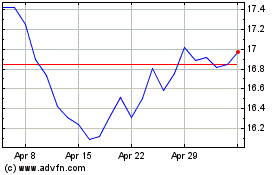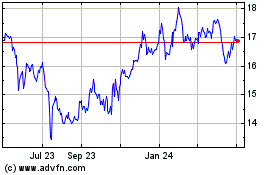AT&T Pinched by Cord-Cutting and Closed Theaters --2nd Update
October 22 2020 - 11:35AM
Dow Jones News
By Drew FitzGerald
AT&T Inc.'s big media bets dragged down results in the
latest quarter, as closed movie theaters and pay-television
customer losses offset the growth at its core wireless and
broadband businesses.
The telecom and media giant said Thursday that 8.6 million
customers had activated HBO Max, its Netflix-like streaming video
service, by the end of September, up from 4.1 million shortly after
its May launch. The total still trails rivals Disney+ and Hulu, but
AT&T executives said HBO's user base was growing faster than
expected.
"The reason we're doing HBO Max is because we want to be where
the customers want to be," AT&T Chief Executive John Stankey
said Thursday during a call with analysts. "It's a tough
environment, but we're managing well."
The wireless business, which remains the heart of AT&T's
profit engine, added 645,000 postpaid phone subscribers. That is
more than double the phone connections gain reported by Verizon
Communications Inc. during the same period.
AT&T's pay-TV division continued trending in the other
direction, shedding 627,000 video customers. That result was still
an improvement over the roughly one million video customers lost in
each of the previous two quarters. The unit, which includes
DirecTV, has suffered the lion's share of cord-cutting in recent
years, prompting the company to explore a sale of the satellite
business.
Overall, AT&T's quarterly revenue dropped 5% to $42.3
billion. The company attributed a roughly $2.5 billion revenue loss
to Covid-19, as theater closures shrank box-office receipts from
Warner Bros. movies and wireless roaming fees dried up.
AT&T and media rivals Walt Disney Co. and Comcast Corp. have
started cutting thousands of jobs to offset business lost to the
coronavirus pandemic. The virus has sapped the advertising market
and delayed the release of major movies.
That market pressure prompted WarnerMedia to start a broad
corporate shake-up to trim overhead costs and turn the
movie-and-film producer into a more unified company. Executives
seek to cut the division's expenses by as much as 20%, according to
people familiar with the plans.
AT&T's overall quarterly profit fell to about $2.8 billion,
or 39 cents a share, compared with about $3.7 billion, or 50 cents,
a year earlier. The result included about 21 cents of per-share
costs tied to the pandemic.
Stable wireless revenue allowed the company to tweak its
full-year cash flow projection despite the pandemic-related costs.
The company said it expects free cash flow to reach $26 billion or
higher, with its dividend payout ratio in the high 50% range. That
rate would support the nearly $15 billion in annual dividend
payments expected earlier this year, before the coronavirus
pandemic forced the company to withdraw its earlier forecasts.
AT&T finance chief John Stephens called the latest cash
projection "a healthy and comfortable position."
"We feel good about the dividend and the ability to provide the
board the flexibility to continue to pay and manage that dividend,"
Mr. Stephens said in an interview.
The latest quarter included 151,000 paying wireless subscribers
retained under Keep Americans Connected, a program launched as a
federal coronavirus forbearance initiative. The company also
reported a net gain of 158,000 broadband subscribers, a figure that
included 104,000 accounts on a Keep Americans Connected plan.
The Dallas company's communication business outside the U.S.
also bounced back. The Mexican wireless business gained 441,000
wireless customers, while the Vrio satellite-TV unit added 229,000
accounts across Latin America after two quarterly declines.
AT&T is counting on HBO Max to offset its declining
entertainment assets with new income from a growing
direct-to-consumer model. HBO's cable-TV and online distribution
channels have complicated that pivot. In the September quarter, the
overall number of customers watching HBO in any form rose to 38
million in the U.S. and 57 million world-wide, exceeding the
company's target for the year.
Some HBO viewers remain unaware that their subscriptions entitle
them to the new content-heavy app, while others are unable to
upgrade because of business disputes that have kept the service off
Amazon.com Inc. and Roku Inc. devices.
Mr. Stankey said earlier this week at The Wall Street Journal's
Tech Live conference that the market power of tech giants like
Amazon warranted more scrutiny. The telecom company reached deals
earlier this year with cable partners including Comcast and Charter
Communications Inc. to make the app available to existing HBO
subscribers.
The company said it remains on track to launch an ad-supported
HBO Max version next year. WarnerMedia also plans to expand HBO Max
into Latin America and western Europe in the months ahead.
AT&T shares rose about 5% to $28 early Thursday after news
of growth in the wireless unit, the company's largest in terms of
revenue and profit. The stock is off about 28% so far this
year.
Write to Drew FitzGerald at andrew.fitzgerald@wsj.com
(END) Dow Jones Newswires
October 22, 2020 11:20 ET (15:20 GMT)
Copyright (c) 2020 Dow Jones & Company, Inc.
AT&T (NYSE:T)
Historical Stock Chart
From Mar 2024 to Apr 2024

AT&T (NYSE:T)
Historical Stock Chart
From Apr 2023 to Apr 2024
